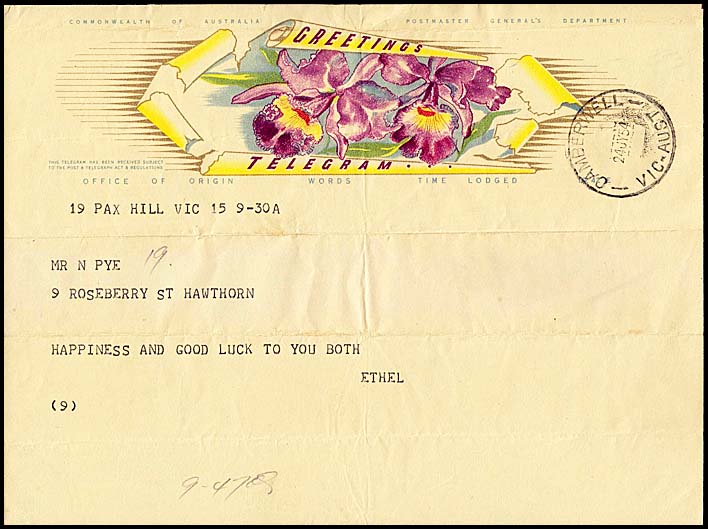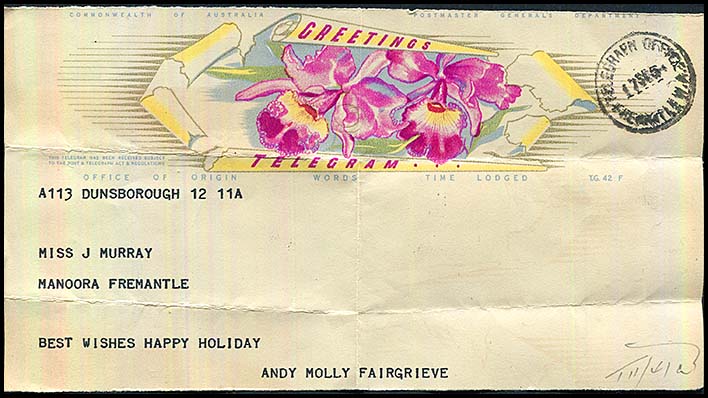1954 Greetings Telegram: AW-GS-54.
- Home, index, site details
- Australia 1901-1988
-
New South Wales
- Overview of NSW
- Organisation
- Telegraph lines
- Telegraph Offices
- Date stamps
- Forms
- Envelopes
- Rates
- Stamps
-
Queensland
- Overview of Qld
- Telegraph lines
- Telegraph Offices
- Date stamps
- Forms
- Envelopes
- Rates
- Stamps
- Ephemera
-
South Australia
- Overview of SA
- Organisation
- Telegraph lines
- Telegraph offices
- Date stamps
- Forms
- Envelopes
- Rates
- Stamps
-
Tasmania
- Overview of Tasmania
- Organisation
- Telegraph lines
- Telegraph Offices
- Date stamps
- Forms
- Envelopes
- Railway lines
- Rates
- Stamps
-
Victoria
- Overview of Victoria
- Organisation
- Telegraph lines
- Telegraph Offices
- Date stamps
- Forms
- Envelopes
- Rates
- Stamps
- Ephemera
-
Western Australia
- Overview of WA
- Organisation
- Telegraph lines
- Telegraph offices
- Date stamps
- Forms
- Envelopes
- Rates
- Stamps
- International
- Special aspects
| Heading and notes: | Form number T.G. 42 E (sheet format) or T.G. 42F (roll format). Heading is GREETINGS TELEGRAM. |
| Message area: | Blank. |
| Reverse side: | Blank. |
| Colours (text & form): | Multicoloured on cream. |
| Size of form overall: | 152 × 203 mm (roll format). |
- has two orchids in an opening scroll;
- the main items printed are:
Forms:
F-54A: scroll folds above R of ORIGIN - sheet format (number T.G. 42E);
F-54B: scroll folds above R of ORIGIN - roll format (number is T.G. 54F). - F-54C: scroll folds between R and I of ORIGIN - sheet format (number T.G. 54E)
- F-54D: scroll folds between R and I of ORIGIN- roll format (number T.G. 54F).
Envelopes:
No matching envelopes were issued with this form.
This Greetings telegram followed the release of the other two ornamental greetings telegram available at this time - the 1953 Christmas Greetings telegram and the 1954 Congratulations telegram. The re-introduction of these special forms resulted from the greater availability of paper after the war-time restrictions.
The forms continued to be issued until at least 1959.
 |
AW-GSF-54A.
Pax Hill to Camberwell, Vic Characteristics:
|
 |
AW-GSF-54B.
Tumut to Fremantle. For delivery to the SS Orantes at Fremantle. Characteristics:
|
 Telegram sent to Australian Cricketer Ray Lindwall after he had set the world record for the most number of test wickets (211). For further cricket telegram references, see Cricket. |
AW-GSF-54C.
Brisbane to Cricket Ground Melbourne (CTO) Characteristics:
|
|
AW-GSF-54D.
Dunsborough to Fremantle. For delivery to the TSMV Manoora at Fremantle. Characteristics:
|
The TSMV Manoora was laid down in 1934 in Glasgow, Scotland. She she made her maiden Australian coastal voyage from Sydney to Fremantle (Western Australia) on April 11, 1935. After the outbreak of hostilities, she was commissioned by the Navy in October 1939 and refitted for service as an armed merchant cruiser (AMC). She was officially commissioned on December 12, 1939 and took up patrol duties in the Coral Sea and in The Pacific. Later she was converted to a Landing Ship, Infantry with a 1,230 person capacity. HMAS Manoora was decommissioned on December 6, 1947 and laid up for 12 months before being recommissioned and the TSMV Manoora returned to service on 31 August 1949. Air travel became increasingly popular and so, in 1959, the Adelaide Steamship company used the Manoora on Pacific cruises before returning her to coastal duties. She was the last Australian coastal liner. She was purchased by the Indonesian Government, who renamed her TSMV Ambulombo before she departed Melbourne with an Indonesian crew for the last time on 26 August, 1961. She became a pilgrim ship travelling between Indonesia and Mecca. Finally, she was sold for scrap to a Taiwanese company but, on the tow from Indonesia, she sprang a leak and sank off Luzon on 18 November 1972. Her supporters regarded that as a dignified (and better) end to a grand old lady. |
|
Details of use and rarity.
| Form sub-number |
Schedule number | Earliest recorded date | Rarity rating |
| GSF-54A | None. | 24 July 1954 at Camberwell, Vic. | C |
| GSF-54B | None. | 20 July 1955 at Telegraph Office,Fremantle, WA. | NC |
| GSF-54C | None. | 21 March 1955 at Port Pirie, SA. | C |
| GSF-54D | None. | 17 September 1954 at Freemantle. WA | NC |
